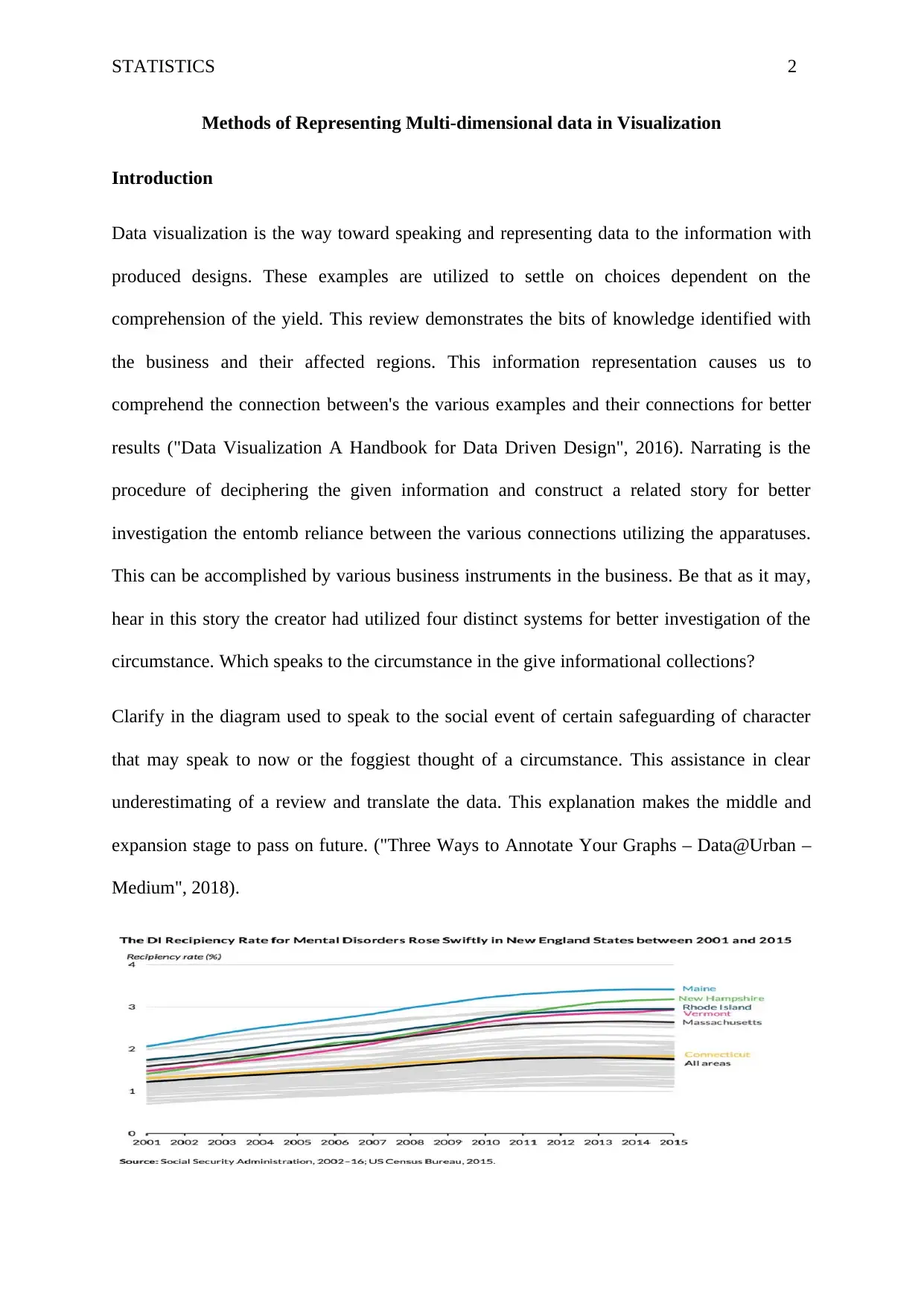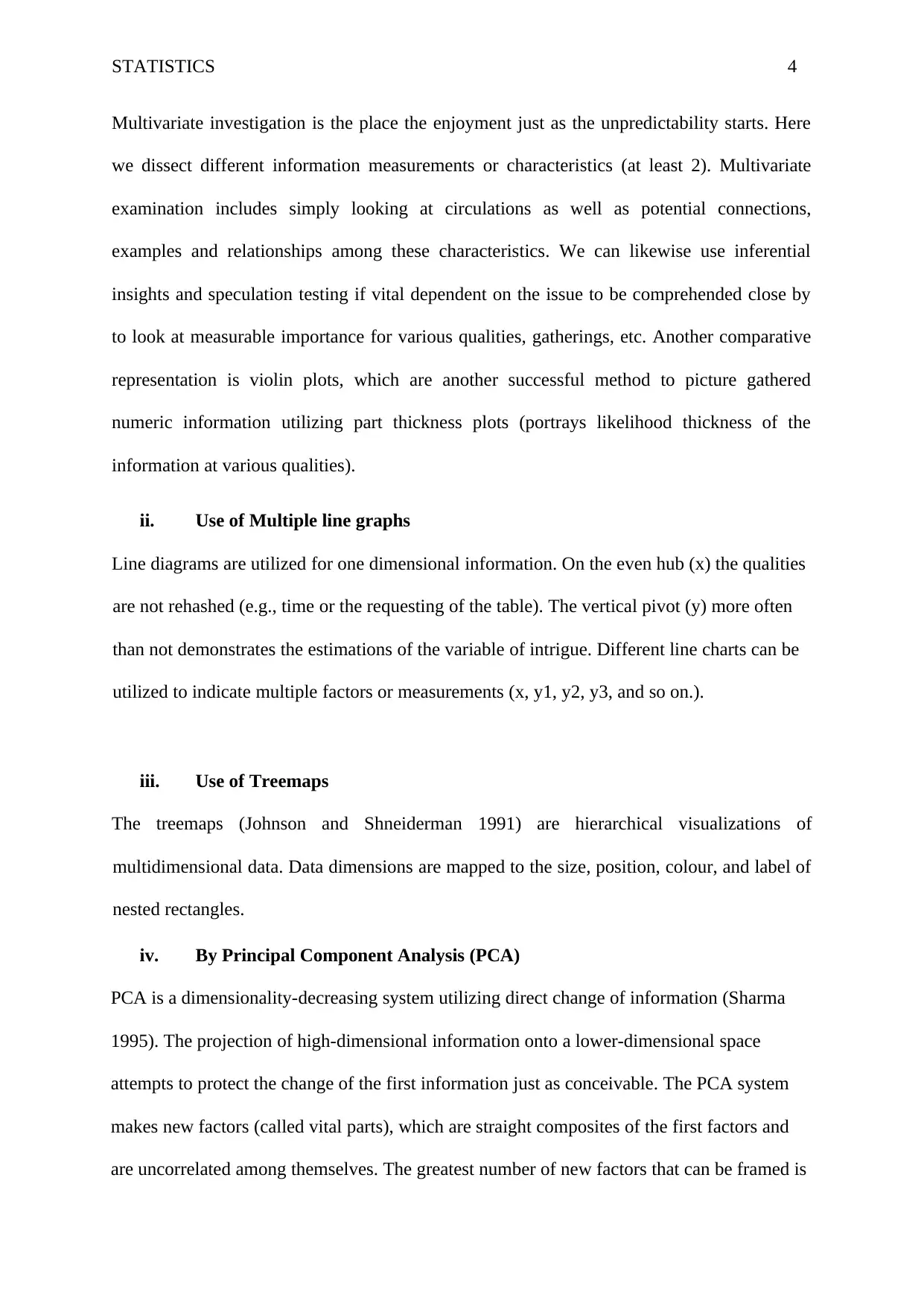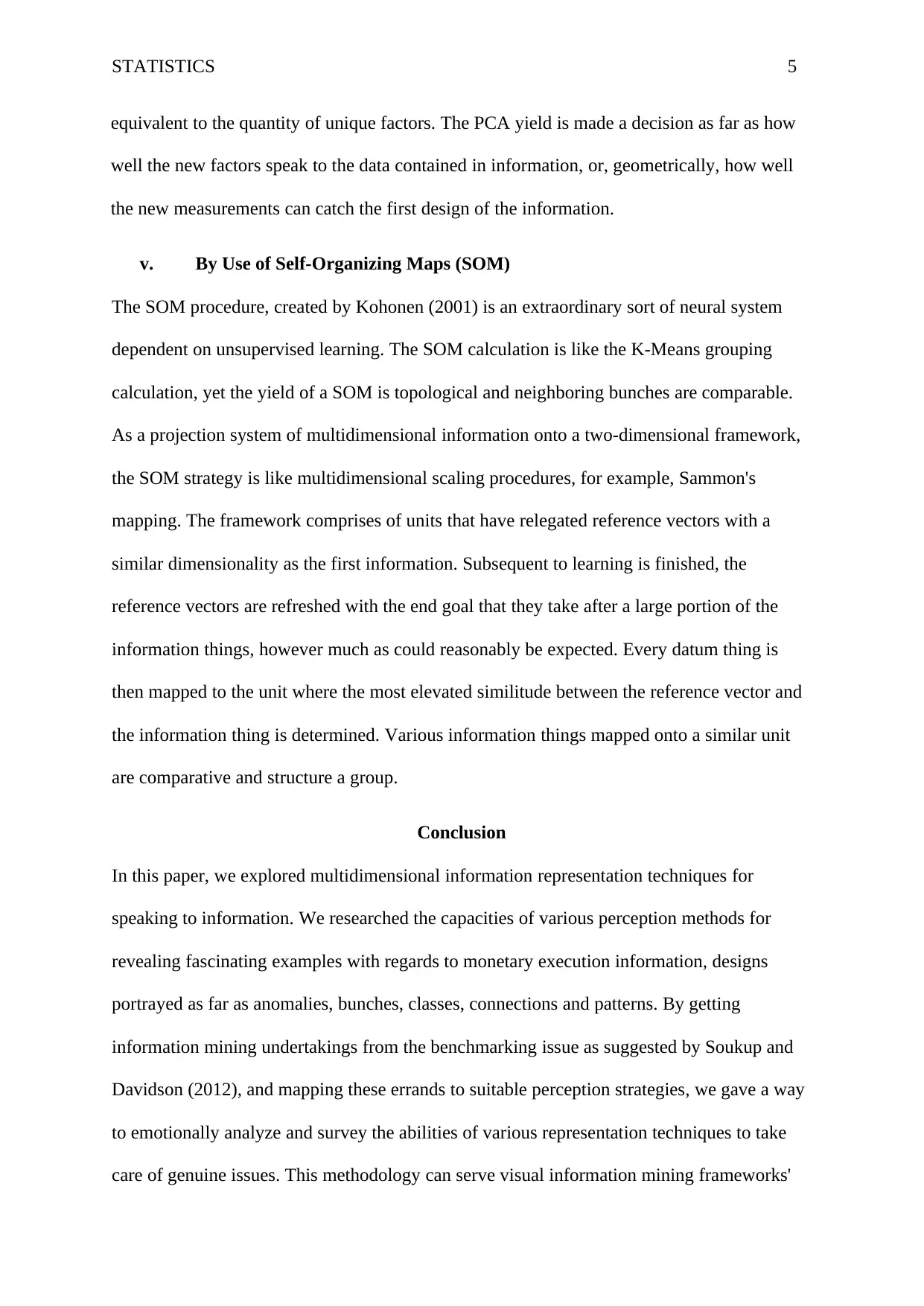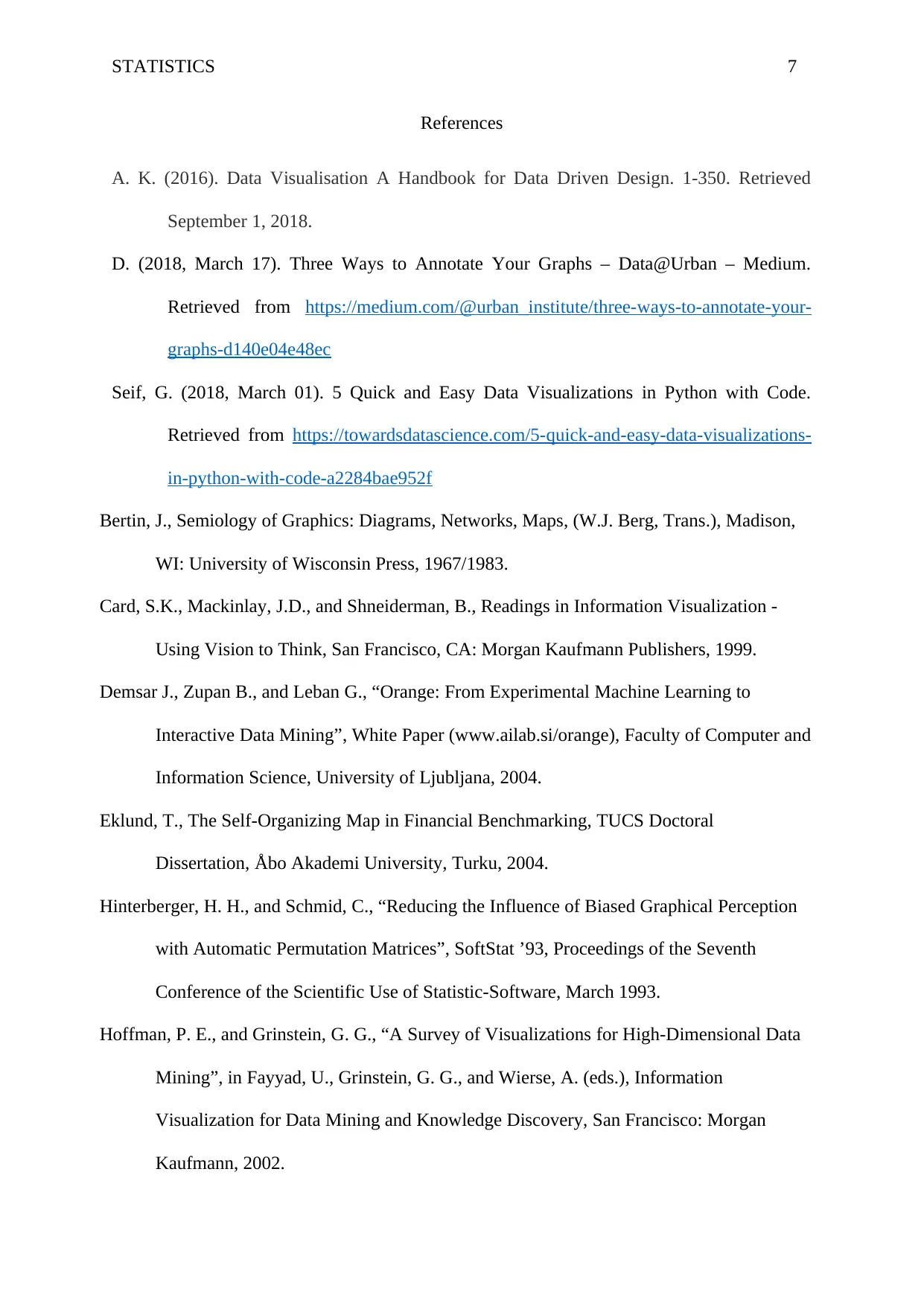A Report on Representing Multi-dimensional Data in Data Visualization
VerifiedAdded on 2023/03/31
|9
|1285
|62
Report
AI Summary
This report explores various methods for representing multi-dimensional data in visualization, emphasizing the importance of effective data representation for informed decision-making. It discusses techniques such as composition, multiple line graphs, treemaps, Principal Component Analysis (PCA), and Self-Organizing Maps (SOM). Each method is analyzed for its strengths and applications in revealing patterns, anomalies, and relationships within complex datasets. The report concludes by highlighting the significance of selecting appropriate visualization techniques to address real-world problems and improve the quality of data mining frameworks. Desklib provides a platform to access this and many other solved assignments to aid students in their academic endeavors.

Running head: STATISTICS 1
Methods of Representing Multi-dimensional data in Visualization
By (Name of Student)
(Institutional Affiliation)
(Date of Submission)
Methods of Representing Multi-dimensional data in Visualization
By (Name of Student)
(Institutional Affiliation)
(Date of Submission)
Paraphrase This Document
Need a fresh take? Get an instant paraphrase of this document with our AI Paraphraser

STATISTICS 2
Methods of Representing Multi-dimensional data in Visualization
Introduction
Data visualization is the way toward speaking and representing data to the information with
produced designs. These examples are utilized to settle on choices dependent on the
comprehension of the yield. This review demonstrates the bits of knowledge identified with
the business and their affected regions. This information representation causes us to
comprehend the connection between's the various examples and their connections for better
results ("Data Visualization A Handbook for Data Driven Design", 2016). Narrating is the
procedure of deciphering the given information and construct a related story for better
investigation the entomb reliance between the various connections utilizing the apparatuses.
This can be accomplished by various business instruments in the business. Be that as it may,
hear in this story the creator had utilized four distinct systems for better investigation of the
circumstance. Which speaks to the circumstance in the give informational collections?
Clarify in the diagram used to speak to the social event of certain safeguarding of character
that may speak to now or the foggiest thought of a circumstance. This assistance in clear
underestimating of a review and translate the data. This explanation makes the middle and
expansion stage to pass on future. ("Three Ways to Annotate Your Graphs – Data@Urban –
Medium", 2018).
Methods of Representing Multi-dimensional data in Visualization
Introduction
Data visualization is the way toward speaking and representing data to the information with
produced designs. These examples are utilized to settle on choices dependent on the
comprehension of the yield. This review demonstrates the bits of knowledge identified with
the business and their affected regions. This information representation causes us to
comprehend the connection between's the various examples and their connections for better
results ("Data Visualization A Handbook for Data Driven Design", 2016). Narrating is the
procedure of deciphering the given information and construct a related story for better
investigation the entomb reliance between the various connections utilizing the apparatuses.
This can be accomplished by various business instruments in the business. Be that as it may,
hear in this story the creator had utilized four distinct systems for better investigation of the
circumstance. Which speaks to the circumstance in the give informational collections?
Clarify in the diagram used to speak to the social event of certain safeguarding of character
that may speak to now or the foggiest thought of a circumstance. This assistance in clear
underestimating of a review and translate the data. This explanation makes the middle and
expansion stage to pass on future. ("Three Ways to Annotate Your Graphs – Data@Urban –
Medium", 2018).

STATISTICS 3
Colours
Data visualization can be accomplished all the more successfully by utilizing the shading
system for review various stages in information for better understanding. The view can
experience shading perception better then every for a mind boggling information portrayal.
(Seif, 2019)
Methods
i. Composition
This is a standout amongst the most miss utilized system in the information perception for
portrayal of the information. Its fundamental thought is to demonstrate the individual
information parts in the entire blend of data them show them with aggregate changes. It can
likewise be utilized to demonstrate the all out an incentive in parts or the features of the data
for better examination. A typical missus of this system is its done when numerous parts are
utilized to creation of set with little varieties.
Colours
Data visualization can be accomplished all the more successfully by utilizing the shading
system for review various stages in information for better understanding. The view can
experience shading perception better then every for a mind boggling information portrayal.
(Seif, 2019)
Methods
i. Composition
This is a standout amongst the most miss utilized system in the information perception for
portrayal of the information. Its fundamental thought is to demonstrate the individual
information parts in the entire blend of data them show them with aggregate changes. It can
likewise be utilized to demonstrate the all out an incentive in parts or the features of the data
for better examination. A typical missus of this system is its done when numerous parts are
utilized to creation of set with little varieties.
⊘ This is a preview!⊘
Do you want full access?
Subscribe today to unlock all pages.

Trusted by 1+ million students worldwide

STATISTICS 4
Multivariate investigation is the place the enjoyment just as the unpredictability starts. Here
we dissect different information measurements or characteristics (at least 2). Multivariate
examination includes simply looking at circulations as well as potential connections,
examples and relationships among these characteristics. We can likewise use inferential
insights and speculation testing if vital dependent on the issue to be comprehended close by
to look at measurable importance for various qualities, gatherings, etc. Another comparative
representation is violin plots, which are another successful method to picture gathered
numeric information utilizing part thickness plots (portrays likelihood thickness of the
information at various qualities).
ii. Use of Multiple line graphs
Line diagrams are utilized for one dimensional information. On the even hub (x) the qualities
are not rehashed (e.g., time or the requesting of the table). The vertical pivot (y) more often
than not demonstrates the estimations of the variable of intrigue. Different line charts can be
utilized to indicate multiple factors or measurements (x, y1, y2, y3, and so on.).
iii. Use of Treemaps
The treemaps (Johnson and Shneiderman 1991) are hierarchical visualizations of
multidimensional data. Data dimensions are mapped to the size, position, colour, and label of
nested rectangles.
iv. By Principal Component Analysis (PCA)
PCA is a dimensionality-decreasing system utilizing direct change of information (Sharma
1995). The projection of high-dimensional information onto a lower-dimensional space
attempts to protect the change of the first information just as conceivable. The PCA system
makes new factors (called vital parts), which are straight composites of the first factors and
are uncorrelated among themselves. The greatest number of new factors that can be framed is
Multivariate investigation is the place the enjoyment just as the unpredictability starts. Here
we dissect different information measurements or characteristics (at least 2). Multivariate
examination includes simply looking at circulations as well as potential connections,
examples and relationships among these characteristics. We can likewise use inferential
insights and speculation testing if vital dependent on the issue to be comprehended close by
to look at measurable importance for various qualities, gatherings, etc. Another comparative
representation is violin plots, which are another successful method to picture gathered
numeric information utilizing part thickness plots (portrays likelihood thickness of the
information at various qualities).
ii. Use of Multiple line graphs
Line diagrams are utilized for one dimensional information. On the even hub (x) the qualities
are not rehashed (e.g., time or the requesting of the table). The vertical pivot (y) more often
than not demonstrates the estimations of the variable of intrigue. Different line charts can be
utilized to indicate multiple factors or measurements (x, y1, y2, y3, and so on.).
iii. Use of Treemaps
The treemaps (Johnson and Shneiderman 1991) are hierarchical visualizations of
multidimensional data. Data dimensions are mapped to the size, position, colour, and label of
nested rectangles.
iv. By Principal Component Analysis (PCA)
PCA is a dimensionality-decreasing system utilizing direct change of information (Sharma
1995). The projection of high-dimensional information onto a lower-dimensional space
attempts to protect the change of the first information just as conceivable. The PCA system
makes new factors (called vital parts), which are straight composites of the first factors and
are uncorrelated among themselves. The greatest number of new factors that can be framed is
Paraphrase This Document
Need a fresh take? Get an instant paraphrase of this document with our AI Paraphraser

STATISTICS 5
equivalent to the quantity of unique factors. The PCA yield is made a decision as far as how
well the new factors speak to the data contained in information, or, geometrically, how well
the new measurements can catch the first design of the information.
v. By Use of Self-Organizing Maps (SOM)
The SOM procedure, created by Kohonen (2001) is an extraordinary sort of neural system
dependent on unsupervised learning. The SOM calculation is like the K-Means grouping
calculation, yet the yield of a SOM is topological and neighboring bunches are comparable.
As a projection system of multidimensional information onto a two-dimensional framework,
the SOM strategy is like multidimensional scaling procedures, for example, Sammon's
mapping. The framework comprises of units that have relegated reference vectors with a
similar dimensionality as the first information. Subsequent to learning is finished, the
reference vectors are refreshed with the end goal that they take after a large portion of the
information things, however much as could reasonably be expected. Every datum thing is
then mapped to the unit where the most elevated similitude between the reference vector and
the information thing is determined. Various information things mapped onto a similar unit
are comparative and structure a group.
Conclusion
In this paper, we explored multidimensional information representation techniques for
speaking to information. We researched the capacities of various perception methods for
revealing fascinating examples with regards to monetary execution information, designs
portrayed as far as anomalies, bunches, classes, connections and patterns. By getting
information mining undertakings from the benchmarking issue as suggested by Soukup and
Davidson (2012), and mapping these errands to suitable perception strategies, we gave a way
to emotionally analyze and survey the abilities of various representation techniques to take
care of genuine issues. This methodology can serve visual information mining frameworks'
equivalent to the quantity of unique factors. The PCA yield is made a decision as far as how
well the new factors speak to the data contained in information, or, geometrically, how well
the new measurements can catch the first design of the information.
v. By Use of Self-Organizing Maps (SOM)
The SOM procedure, created by Kohonen (2001) is an extraordinary sort of neural system
dependent on unsupervised learning. The SOM calculation is like the K-Means grouping
calculation, yet the yield of a SOM is topological and neighboring bunches are comparable.
As a projection system of multidimensional information onto a two-dimensional framework,
the SOM strategy is like multidimensional scaling procedures, for example, Sammon's
mapping. The framework comprises of units that have relegated reference vectors with a
similar dimensionality as the first information. Subsequent to learning is finished, the
reference vectors are refreshed with the end goal that they take after a large portion of the
information things, however much as could reasonably be expected. Every datum thing is
then mapped to the unit where the most elevated similitude between the reference vector and
the information thing is determined. Various information things mapped onto a similar unit
are comparative and structure a group.
Conclusion
In this paper, we explored multidimensional information representation techniques for
speaking to information. We researched the capacities of various perception methods for
revealing fascinating examples with regards to monetary execution information, designs
portrayed as far as anomalies, bunches, classes, connections and patterns. By getting
information mining undertakings from the benchmarking issue as suggested by Soukup and
Davidson (2012), and mapping these errands to suitable perception strategies, we gave a way
to emotionally analyze and survey the abilities of various representation techniques to take
care of genuine issues. This methodology can serve visual information mining frameworks'

STATISTICS 6
engineers in surveying the quality of different procedures in the beginning time of framework
improvement and in like manner select the most suitable systems. The methodology can be
stretched out by including clients in further assessment investigations of the chose
representation procedures.
engineers in surveying the quality of different procedures in the beginning time of framework
improvement and in like manner select the most suitable systems. The methodology can be
stretched out by including clients in further assessment investigations of the chose
representation procedures.
⊘ This is a preview!⊘
Do you want full access?
Subscribe today to unlock all pages.

Trusted by 1+ million students worldwide

STATISTICS 7
References
A. K. (2016). Data Visualisation A Handbook for Data Driven Design. 1-350. Retrieved
September 1, 2018.
D. (2018, March 17). Three Ways to Annotate Your Graphs – Data@Urban – Medium.
Retrieved from https://medium.com/@urban_institute/three-ways-to-annotate-your-
graphs-d140e04e48ec
Seif, G. (2018, March 01). 5 Quick and Easy Data Visualizations in Python with Code.
Retrieved from https://towardsdatascience.com/5-quick-and-easy-data-visualizations-
in-python-with-code-a2284bae952f
Bertin, J., Semiology of Graphics: Diagrams, Networks, Maps, (W.J. Berg, Trans.), Madison,
WI: University of Wisconsin Press, 1967/1983.
Card, S.K., Mackinlay, J.D., and Shneiderman, B., Readings in Information Visualization -
Using Vision to Think, San Francisco, CA: Morgan Kaufmann Publishers, 1999.
Demsar J., Zupan B., and Leban G., “Orange: From Experimental Machine Learning to
Interactive Data Mining”, White Paper (www.ailab.si/orange), Faculty of Computer and
Information Science, University of Ljubljana, 2004.
Eklund, T., The Self-Organizing Map in Financial Benchmarking, TUCS Doctoral
Dissertation, Åbo Akademi University, Turku, 2004.
Hinterberger, H. H., and Schmid, C., “Reducing the Influence of Biased Graphical Perception
with Automatic Permutation Matrices”, SoftStat ’93, Proceedings of the Seventh
Conference of the Scientific Use of Statistic-Software, March 1993.
Hoffman, P. E., and Grinstein, G. G., “A Survey of Visualizations for High-Dimensional Data
Mining”, in Fayyad, U., Grinstein, G. G., and Wierse, A. (eds.), Information
Visualization for Data Mining and Knowledge Discovery, San Francisco: Morgan
Kaufmann, 2002.
References
A. K. (2016). Data Visualisation A Handbook for Data Driven Design. 1-350. Retrieved
September 1, 2018.
D. (2018, March 17). Three Ways to Annotate Your Graphs – Data@Urban – Medium.
Retrieved from https://medium.com/@urban_institute/three-ways-to-annotate-your-
graphs-d140e04e48ec
Seif, G. (2018, March 01). 5 Quick and Easy Data Visualizations in Python with Code.
Retrieved from https://towardsdatascience.com/5-quick-and-easy-data-visualizations-
in-python-with-code-a2284bae952f
Bertin, J., Semiology of Graphics: Diagrams, Networks, Maps, (W.J. Berg, Trans.), Madison,
WI: University of Wisconsin Press, 1967/1983.
Card, S.K., Mackinlay, J.D., and Shneiderman, B., Readings in Information Visualization -
Using Vision to Think, San Francisco, CA: Morgan Kaufmann Publishers, 1999.
Demsar J., Zupan B., and Leban G., “Orange: From Experimental Machine Learning to
Interactive Data Mining”, White Paper (www.ailab.si/orange), Faculty of Computer and
Information Science, University of Ljubljana, 2004.
Eklund, T., The Self-Organizing Map in Financial Benchmarking, TUCS Doctoral
Dissertation, Åbo Akademi University, Turku, 2004.
Hinterberger, H. H., and Schmid, C., “Reducing the Influence of Biased Graphical Perception
with Automatic Permutation Matrices”, SoftStat ’93, Proceedings of the Seventh
Conference of the Scientific Use of Statistic-Software, March 1993.
Hoffman, P. E., and Grinstein, G. G., “A Survey of Visualizations for High-Dimensional Data
Mining”, in Fayyad, U., Grinstein, G. G., and Wierse, A. (eds.), Information
Visualization for Data Mining and Knowledge Discovery, San Francisco: Morgan
Kaufmann, 2002.
Paraphrase This Document
Need a fresh take? Get an instant paraphrase of this document with our AI Paraphraser

STATISTICS 8
Inselberg, A., “The Plane with Parallel Coordinates”, Special Issue on Computational
Geometry, The Visual Computer 1, 1985, pp. 69–91.
Johnson, B., and Shneiderman, B., “Treemaps: A Space-Filling Approach to the Visualization
of Hierarchical Information Structures”, Proc. of IEEE Visualization ’91 Conf., San
Diego, 1991, pp. 28–4 291.
Keim, D.A., “Information Visualization and Visual Data Mining”, IEEE Transactions on
Visualization and Computer Graphics, Vol. 8, No. 1, January-March 2002.
Kohavi, R., Rothleder, N. J., and Simoudis, E., “Emerging Trends in Business Analytics”,
Communications of the ACM, 45(8), 2002, pp. 45-48.
Inselberg, A., “The Plane with Parallel Coordinates”, Special Issue on Computational
Geometry, The Visual Computer 1, 1985, pp. 69–91.
Johnson, B., and Shneiderman, B., “Treemaps: A Space-Filling Approach to the Visualization
of Hierarchical Information Structures”, Proc. of IEEE Visualization ’91 Conf., San
Diego, 1991, pp. 28–4 291.
Keim, D.A., “Information Visualization and Visual Data Mining”, IEEE Transactions on
Visualization and Computer Graphics, Vol. 8, No. 1, January-March 2002.
Kohavi, R., Rothleder, N. J., and Simoudis, E., “Emerging Trends in Business Analytics”,
Communications of the ACM, 45(8), 2002, pp. 45-48.

STATISTICS 9
⊘ This is a preview!⊘
Do you want full access?
Subscribe today to unlock all pages.

Trusted by 1+ million students worldwide
1 out of 9
Related Documents
Your All-in-One AI-Powered Toolkit for Academic Success.
+13062052269
info@desklib.com
Available 24*7 on WhatsApp / Email
![[object Object]](/_next/static/media/star-bottom.7253800d.svg)
Unlock your academic potential
Copyright © 2020–2025 A2Z Services. All Rights Reserved. Developed and managed by ZUCOL.




